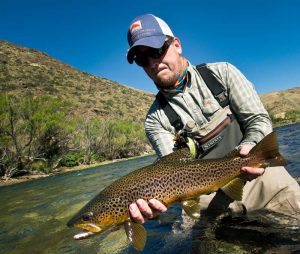
Photo by Louis Cahill
By Justin Pickett
One of the most common areas of needed improvement that I see with many anglers is line management.
In fly fishing, line management is a big piece of the puzzle, and to be consistently successful you must improve upon these skills and develop good habits. One particularly bad habit that I see more than any other when I’m on the water with clients and other anglers is having an unnecessary amount of line stripped off the reel. This is problematic for numerous reasons.
One obvious reason is that your fly line could become entangled while fighting a fish and cause you to lose a fish. Laying a ton of line on the ground invites a host of gremlins to grab on and ruin your efforts. Most trout lines are also very supple and thin, making them even more prone to tangle and knot up when being taken from the ground quickly, whether it be a fish on the run or from the act of shooting line. Fly line left on the ground, or even in the water, also lends itself to damage. You can easily shred a fly line and even cut through a line by stepping on it. I’ve had one of my lines severed in half when a client of mine wearing aluminum barred boots stepped on it, leaving that rig useless until we stopped to grab another reel. Dirt and grime also loves to stick to fly lines, especially textured lines, which will greatly hinder your fly line’s ability to float effectively on the water’s surface. Problems, problems, problems.
Often, a situation doesn’t call for more fly line, but rather for the angler to get out of their “box”.
For example, there was a morning I was setting up a client to make the first presentation of the day, which required about a thirty-foot cast. Nothing crazy. As he set his feet and prepared for his cast, I turned to pull my net from my pack in an act of optimism. As I did this all I could hear was the sound of the intermittent outgoing clicks of the drag on his reel. A lot of them. When I turned back to him, there was an epic pile of fly line at his feet that could have easily reached the gates of The North. I interrupted him as he began to make his first false cast to ask why he felt he needed eighty feet of line for a thirty-foot cast, to which he replied, “I guess I don’t really need that much.”
It turns out this was just a dirty habit that he picked up throughout his years on the water, and I assured him that he certainly isn’t alone. Throughout the day, when only minute changes needed to be made in order to reach a different piece of water, his instinct was to pull more line from the reel, even if he didn’t need it.
 Most fly rods are nine feet in length and are made of expensive, bendy graphite and are marketed to anglers for their casting prowess. That’s great, but don’t forget that the length of that rod isn’t just for casting. Use all nine feet of that sucker during every phase of your presentation! There have been so many times that I’ve been able to successfully accomplish my next drift by simply reaching out with my rod, using its length to get my fly into drifts further away.
Most fly rods are nine feet in length and are made of expensive, bendy graphite and are marketed to anglers for their casting prowess. That’s great, but don’t forget that the length of that rod isn’t just for casting. Use all nine feet of that sucker during every phase of your presentation! There have been so many times that I’ve been able to successfully accomplish my next drift by simply reaching out with my rod, using its length to get my fly into drifts further away.
By simply extending my arm and leaning into the drift, I can cover more water without requiring more fly line, allowing for more control and less mess.
When that eat does happen, the last thing I want to have to worry about is what my fly line is doing. If you are one of the many anglers that have developed the habit of pulling unnecessary line from the reel, focus on kicking this habit using all of the tools (in this case your rod and your arm) at your disposal to lengthen your presentation. Getting rid of that tangled pile of fly line at your feet will likely solve a lot of the problems that you face during your outings on the water. Happy Fishing!
Justin Pickett Gink & Gasoline www.ginkandgasoline.com hookups@ginkandgasoline.com Sign Up For Our Weekly Newsletter!